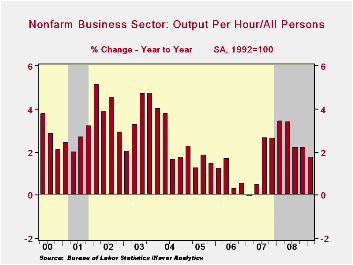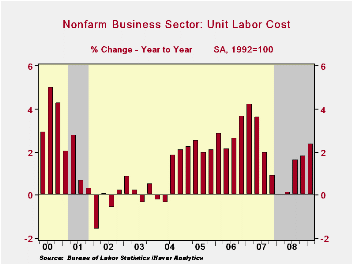 Global| May 07 2009
Global| May 07 2009U.S. Worker Productivity Inches Up, But Underlying Cost Pressures Mount
by:Tom Moeller
|in:Economy in Brief
Summary
It was a recovery, but not much of one. Labor productivity in the nonfarm business sector rose an expected 0.8% (AR) last quarter and mostly recouped a revised 0.6% slip at the end of last year. The latest uptick, however, has done [...]

It was a recovery, but not much of one. Labor productivity in the nonfarm business sector rose an expected 0.8% (AR) last quarter and mostly recouped a revised 0.6% slip at the end of last year. The latest uptick, however, has done little to diminish the drastic weakening of labor productivity of late. The unchanged level over six months is the weakest performance since early-2007 which itself was the poorest in ten years.
Though productivity growth has slowed dramatically, it would have been worse were businesses not quick in responding to the output shortfall by cutting employment and hours-worked. Output fell at an 8.2% annual rate last quarter after falling 8.8% during 4Q '08. These declines marked the quickest back-to-back since early 1958. However, businesses responded quickly by cutting employment and hours worked at a 9.0% rate last quarter and by 8.3% during 4Q. 
The drop in productivity growth has hurt corporations' bottom lines due in no small part to the fact that growth in compensation costs has remained fairly firm. It rose 4.1% last quarter and that lifted the y/y growth to 4.2%. Annually, growth in compensation has been roughly stable near the 4% level since 2001.
The combination of recently diminished productivity growth and stable gains in compensation has increased costs. Growth in unit labor costs remained a firm 3.3% during 1Q following the 5.7% jump during 4Q. The increases raised the six-month growth in costs to 4.5% from just 0.9% during all of last year.
In the factory sector the pressure on corporations' bottom lines has been more intense. Worker productivity fell 3.4% during 1Q (-3.3% y/y), down for the fourth consecutive quarter. Year-to-year, the drop in productivity came as output fell faster (-14.0%) than hours worked (-11.1%). Unit labor cost growth in the factory sector surged again. The 16.7% quarterly rate of increase during 1Q lifted the annual gain to 11.5% which compares to just a 3.2% gain during all of last year. That decline in productivity growth has outpaced firms' ability to cut compensation costs. In fact, there's been no cut at all. Compensation growth of 12.8% last quarter lifted the y/y gain to 7.9%, nearly double last year's 4.1% advance.
The productivity & cost figures are available in Haver's USECON database.
Accounting for cross-country differences in income per capita from the Federal Reserve Bank of Philadelphia can be found here.
| Nonfarm Business Sector (SAAR, %) | 1Q '09 | 4Q '08 | Y/Y | 2008 | 2007 | 2006 |
|---|---|---|---|---|---|---|
| Output per Hour | 0.8 | -0.6 | 1.8 | 2.8 | 1.4 | 0.9 |
| Compensation per Hour | 4.1 | 5.2 | 4.2 | 3.7 | 4.1 | 3.8 |
| Unit Labor Costs | 3.3 | 5.7 | 2.4 | 0.9 | 2.7 | 2.8 |
Tom Moeller
AuthorMore in Author Profile »Prior to joining Haver Analytics in 2000, Mr. Moeller worked as the Economist at Chancellor Capital Management from 1985 to 1999. There, he developed comprehensive economic forecasts and interpreted economic data for equity and fixed income portfolio managers. Also at Chancellor, Mr. Moeller worked as an equity analyst and was responsible for researching and rating companies in the economically sensitive automobile and housing industries for investment in Chancellor’s equity portfolio. Prior to joining Chancellor, Mr. Moeller was an Economist at Citibank from 1979 to 1984. He also analyzed pricing behavior in the metals industry for the Council on Wage and Price Stability in Washington, D.C. In 1999, Mr. Moeller received the award for most accurate forecast from the Forecasters' Club of New York. From 1990 to 1992 he was President of the New York Association for Business Economists. Mr. Moeller earned an M.B.A. in Finance from Fordham University, where he graduated in 1987. He holds a Bachelor of Arts in Economics from George Washington University.






